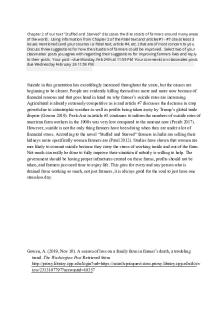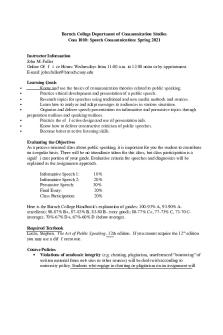COMP-1010 10/17 - COMP 1010, Date-10/17 PDF

| Title | COMP-1010 10/17 - COMP 1010, Date-10/17 |
|---|---|
| Course | Coll Comp/Rhet |
| Institution | University of Wyoming |
| Pages | 2 |
| File Size | 96.4 KB |
| File Type | |
| Total Downloads | 74 |
| Total Views | 165 |
Summary
COMP 1010, Date-10/17...
Description
Draft three MLA annotated bibliography entries--revising previous entries as needed. Use the MLA 8 Citation Template (under WyoCourse Modules > Researched Argument) or use the Purdue OWL (under WyoCourse Modules > General Course Info) to help with the citations. Also, develop an abstract of 200-250 words that includes your argument (or thesis) and main points (meaning your topic sentences or the claims that shape your argument). http://journals.sagepub.com/doi/abs/10.2190/3MFD-569U-K87C-P8CM I would use this source to explain some the negative impacts of beef on the consumer population, not in an environmental or economic way, but in all the chemicals and hormones pumped into the cows. Epstein, Samuel. “The Chemical Jungle: Today's Beef Industry.” International Journal of Health Services, International Journal of Health Services , 1 Apr. 1990, journals.sagepub.com/doi/abs/10.2190/3MFD-569U-K87C-P8CM.
https://search-proquest-com.libproxy.uwyo.edu/docview/1844988531?accountid=14793 This paper offers one possible solution to the issue, genomic technology that would increase the quality of the beef and keep the price the same, or even lower it, which would help the world hunger epidemic, but the environmental impact. Schaffer, Justin A. Measuring the Distribution of Economic Benefits from Adopting Genomic Technology in the U.S. Beef Industry: A Case Study of Myostatin Mutation, University of Wyoming, Ann Arbor, 2016. ProQuest, http://libproxy.uwyo.edu/login/? url=https://search.proquest.com/docview/1844988531?accountid=14793. https://www.feedstuffs.com/commentary/beef-continues-take-center-plate-us This paper presents the issue at hand, but in positive light, that shows the incredible growth the beef industry has experienced, and that nothing will ever change it. Speer, Nevil. “Beef Continues to Take Center Plate in U.S.” Feedstuffs, 14 Sept. 2018, www.feedstuffs.com/commentary/beef-continues-take-center-plate-us.
While the beef industry in America continues to grow, the ability to support it is rapidly decreasing. If no change is initiated, soon the beef industry will collapse upon itself.
One of the potential solutions to the environmental impacts of beef is to start using lab grown beef which would reduce the amount of methane and carbon produced by beef cattle. Another potential solution is to start modifying the cows themselves, reduce their growth time, or find a way to reduce the amount of (gut bacteria stuff?) in the cow's digestive system. By reducing their growth time (reduce time to reach mature slaughtering age) it would reduce not only the amount of food, resources, and water they would need, but also the amount of gases they give off (assuming they don’t produce more gas in a shorter lifespan.) Another way to regulate the beef industry is to put a cap on the amount of beef major beef farms are allowed to produce on a yearly basis. If each major cattle company was allowed to produce a certain amount of beef per year it would not only regulate the amount of beef put out and therefore limit the environmental impact, but would also free up the excess resources to help humans in need across the world. In theory, this would also limit the amount of wasted beef food product. The downside to market regulation is the rise in price in the beef market, however this would increase the popularity of less expensive meat and meat substitutes, such as tofu or soy. Add to the environmental impact, beef is not overly healthy to humans. High in iron, but also high in (other stuff?)......
Similar Free PDFs

Nonverbal Essay SPC 1017
- 2 Pages

One Piece Capitolo 1017 ITA
- 1 Pages

AG 1010
- 2 Pages

Lexi Comp - Lexi comp info
- 4 Pages

Comp Journals
- 5 Pages

Compt - comp
- 3 Pages

COM 1010 Syllabus
- 12 Pages

English-1010-handbook
- 68 Pages

Lab 1 of comp 2650 comp arch
- 1 Pages

Comp - Draft
- 1 Pages

Jv-1010 - Manual español
- 94 Pages

1010 WKW12 - USYD
- 4 Pages

History 1010 lecture 12
- 6 Pages
Popular Institutions
- Tinajero National High School - Annex
- Politeknik Caltex Riau
- Yokohama City University
- SGT University
- University of Al-Qadisiyah
- Divine Word College of Vigan
- Techniek College Rotterdam
- Universidade de Santiago
- Universiti Teknologi MARA Cawangan Johor Kampus Pasir Gudang
- Poltekkes Kemenkes Yogyakarta
- Baguio City National High School
- Colegio san marcos
- preparatoria uno
- Centro de Bachillerato Tecnológico Industrial y de Servicios No. 107
- Dalian Maritime University
- Quang Trung Secondary School
- Colegio Tecnológico en Informática
- Corporación Regional de Educación Superior
- Grupo CEDVA
- Dar Al Uloom University
- Centro de Estudios Preuniversitarios de la Universidad Nacional de Ingeniería
- 上智大学
- Aakash International School, Nuna Majara
- San Felipe Neri Catholic School
- Kang Chiao International School - New Taipei City
- Misamis Occidental National High School
- Institución Educativa Escuela Normal Juan Ladrilleros
- Kolehiyo ng Pantukan
- Batanes State College
- Instituto Continental
- Sekolah Menengah Kejuruan Kesehatan Kaltara (Tarakan)
- Colegio de La Inmaculada Concepcion - Cebu


